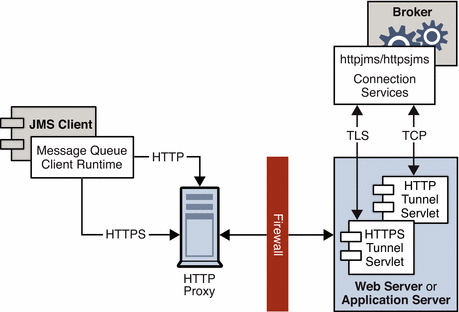HTTP/HTTPS Support Architecture
Message Queue messaging can run on top of HTTP/HTTPS connections. Because HTTP/HTTPS connections are normally allowed through firewalls, this allows client applications to be separated from a broker by a firewall.
Figure C–1 shows the main components involved in providing HTTP/HTTPS support.
-
On the client side, an HTTP or HTTPS transport driver encapsulates the Message Queue message into an HTTP request and makes sure that these requests are sent to the Web server/application server in the correct sequence.
-
The client can use an HTTP proxy server to communicate with the broker if necessary. The proxy’s address is specified using command line options when starting the client. See Using an HTTP Proxy for more information.
-
An HTTP or HTTPS tunnel servlet (both bundled with Message Queue) is loaded in a Web server/application server and used to pull payload messages out of client HTTP requests before forwarding them to the broker. The HTTP/HTTPS tunnel servlet also sends broker messages back to the client in response to HTTP requests made by the client. A single HTTP/HTTPS tunnel servlet can be used to access multiple brokers.
-
On the broker side, the httpjms or httpsjms connection service unwraps and demultiplexes incoming messages from the corresponding tunnel servlet.
-
If the Web server/application server fails and is restarted, all connections are restored and there is no effect on clients. If the broker fails and is restarted, an exception is thrown and clients must re-establish their connections. In the unlikely case that both the Web server/application server and the broker fail, and the broker is not restarted, the Web server/application server will restore client connections and continue waiting for a broker connection— without notifying clients. To avoid this situation, always restart the broker.
Figure C–1 HTTP/HTTPS Support Architecture

As you can see from Figure C–1, the architecture for HTTP and HTTPS support is very similar. The main difference is that, in the case of HTTPS (httpsjms connection service), the tunnel servlet has a secure connection to both the client application and broker.
The secure connection to the broker is provided through an SSL-enabled tunnel servlet—Message Queue’s HTTPS tunnel servlet—which passes a self-signed certificate to any broker requesting a connection. The certificate is used by the broker to set up an encrypted connection to the HTTPS tunnel servlet. Once this connection is established, a secure connection between a client application and the tunnel servlet can be negotiated by the client application and the Web server/application server.
- © 2010, Oracle Corporation and/or its affiliates
